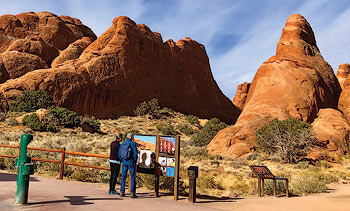 |
| Landscape Arch trailhead |
Scritch. Scratch. Scrunchity scritch. That was the soundscape of my footsteps on a chilly morning as I headed for Landscape Arch. Access to this sandstone ribbon is eighteen miles up the scenic drive from Arches’ Visitor’s Center. The hard-packed trail in Devil’s Garden arrives at a protective wooden post-and-rail fence facing this willowy arch.
Spans, bridges, arches, fins, spires, pillars, and petrified dune fields are the rock stars people come to see in Arches National Park. Our geologic wonderland contains over 2,000 named natural sandstone arches. Span, bridge, arch: what’s the difference? For one thing, a span must have a light opening of at least three feet in one direction to count as an official arch. A natural bridge is distinguished by standing astride a stream or stream channel, though water may not flow year-round. I camped with the Natural Arch and Bridge Society (NABS) on their 2014 field trip to Natural Bridges National Monument. This group supports the study, appreciation, and preservation of natural arches and bridges. Check out their website at naturalarches.org and their newsletter SPAN for more on rock spans around the world. Four types of rock spans are found in Arches: pothole arches (such as Pothole and Bean Pot); cliff wall arches (Park Avenue and Bicep); natural bridges (Walk through Bridge), and free-standing arches (Delicate and Landscape). NABS considers Landscape Arch the longest natural arch in the United States and the fifth longest span in the world.
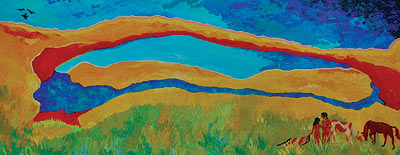 |
| Landscape Arch acrylic painting by Kathy Grossman |
The four others longer than Landscape are found in two regions of China: 1) Xianren “Fairy” Bridge, spanning 400 feet, in Guangxi Zhuang Autonomous Region; 2) Zhijin Natural Bridge, spanning 340 feet in Ghizhou Province; 3) Jiangzhou Immortal Natural Bridge, spanning 310 feet, in Guangxi; and 4) Dachuandong Arch, spanning 300 feet, in Guizhou. Landscape Arch is just 10 feet shorter than Dachuandong, spanning 290 feet. A recent SPAN article described a natural bridge in Ecuador that suddenly formed in February 2020 due to the collapse of a sinkhole behind a waterfall. Once officially measured, it may out-span China’s Fairy Bridge.
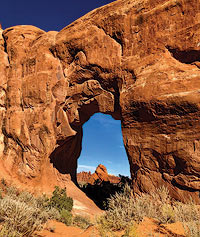 |
| Pine Tree Arch |
On the way to Landscape, two trails branch off .2 miles from the trailhead bringing hikers to Pine Tree and Tunnel Arches. From the spur trail’s Y, take a right to Tunnel Arch (spanning 25.5 feet); back at the Y, hike left to Pine Tree Arch, a new favorite of mine, which spans 46 feet. Back at the main trail, continue ascending northwest on easy grades. Look up from Landscape, and you’ll notice Partition Arch high on the northwest (right) wall. Turning back here will become about a 1.8-mile roundtrip. This trail’s elevation gain is only under 100 feet, but beware! At a mile high, it can challenge the unacclimated. Beyond the arch viewpoint, the trail proceeds to more arches and pillars.
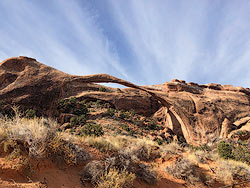 |
| Landscape Arch |
Landscape Arch’s Entrada sandstone span used to be thicker until, on September 1, 1991, snaps, crackles, and pops sent visitors underneath scurrying for their lives as a 60-foot-long rock slab dropped from her thinnest section. Park visitor Michael Müller even caught a video of it. When the dust settled, 180 tons of rock debris lay scattered about. No one was hurt, but you can no longer hike underneath. Speaking of breaking away, the Central Asian country of Uzbekistan gained its independence from the USSR on exactly that same day. To our Uzbek visitors, Xush kelibsiz! Welcome to Utah!
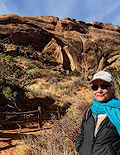
Kathy Grossman Kathy Grossman is a southern California native, a cartoonist, writer, and lover of deserts. Now living between Mill and Pack Creeks, she has been in Moab since 2011.
|